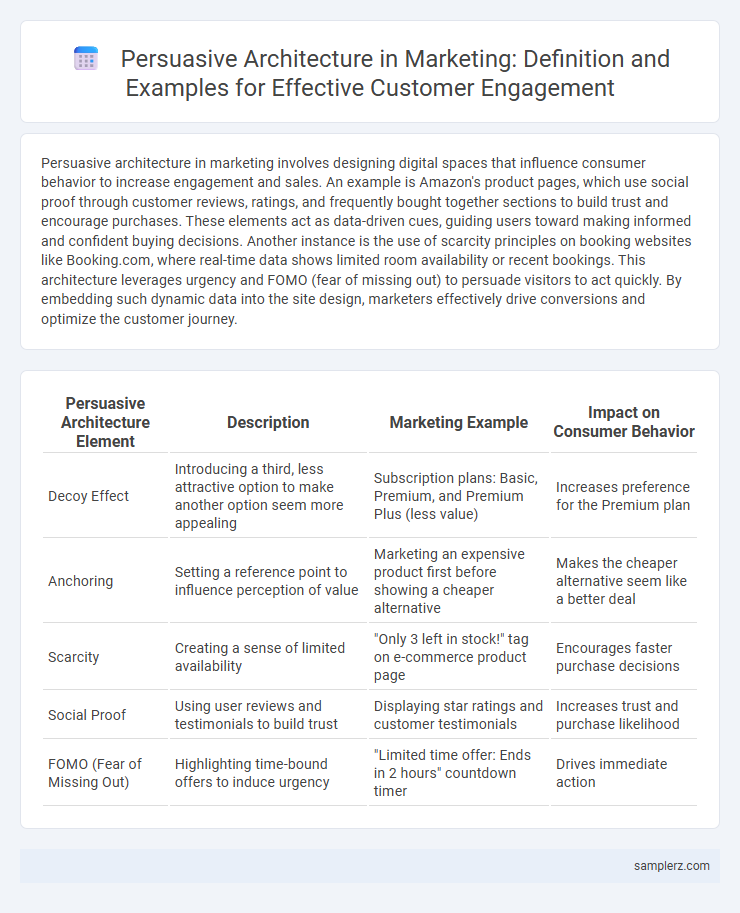Persuasive architecture in marketing involves designing digital spaces that influence consumer behavior to increase engagement and sales. An example is Amazon's product pages, which use social proof through customer reviews, ratings, and frequently bought together sections to build trust and encourage purchases. These elements act as data-driven cues, guiding users toward making informed and confident buying decisions. Another instance is the use of scarcity principles on booking websites like Booking.com, where real-time data shows limited room availability or recent bookings. This architecture leverages urgency and FOMO (fear of missing out) to persuade visitors to act quickly. By embedding such dynamic data into the site design, marketers effectively drive conversions and optimize the customer journey.
Table of Comparison
| Persuasive Architecture Element | Description | Marketing Example | Impact on Consumer Behavior |
|---|---|---|---|
| Decoy Effect | Introducing a third, less attractive option to make another option seem more appealing | Subscription plans: Basic, Premium, and Premium Plus (less value) | Increases preference for the Premium plan |
| Anchoring | Setting a reference point to influence perception of value | Marketing an expensive product first before showing a cheaper alternative | Makes the cheaper alternative seem like a better deal |
| Scarcity | Creating a sense of limited availability | "Only 3 left in stock!" tag on e-commerce product page | Encourages faster purchase decisions |
| Social Proof | Using user reviews and testimonials to build trust | Displaying star ratings and customer testimonials | Increases trust and purchase likelihood |
| FOMO (Fear of Missing Out) | Highlighting time-bound offers to induce urgency | "Limited time offer: Ends in 2 hours" countdown timer | Drives immediate action |
Understanding Persuasive Architecture in Marketing
Persuasive architecture in marketing strategically designs user experiences to guide consumer behavior and decision-making, often through optimized website layouts, clear call-to-actions, and tailored content that aligns with user intent. By leveraging psychological principles such as social proof, scarcity, and reciprocity, marketers create environments that subtly influence purchasing decisions and brand engagement. Effective persuasive architecture enhances conversion rates by seamlessly integrating user needs with business goals within digital platforms.
Key Principles of Persuasive Architecture
Persuasive architecture in marketing leverages principles such as social proof, scarcity, and reciprocity to influence consumer behavior effectively. Utilizing social proof involves displaying customer testimonials and reviews to build trust and credibility, while scarcity creates urgency through limited-time offers or exclusive deals. Reciprocity encourages engagement by providing free value, such as downloadable content or trials, fostering a sense of obligation that drives conversions.
The Role of Psychology in Persuasive Design
Persuasive architecture in marketing leverages psychological principles such as social proof, scarcity, and cognitive biases to influence consumer behavior and decision-making processes. Techniques like using testimonials and limited-time offers tap into trust and urgency, effectively guiding users through conversion funnels. Understanding human psychology allows marketers to craft interfaces that subtly nudge users toward desired actions, enhancing engagement and increasing overall sales.
Landing Pages: Crafting Compelling First Impressions
Landing pages employ persuasive architecture by strategically organizing content to guide visitors toward conversion, using clear headlines, compelling calls-to-action (CTAs), and visual cues to focus attention. Effective layout designs prioritize user experience with minimal distractions, fast load times, and mobile optimization, increasing engagement and reducing bounce rates. Integrating social proof elements like testimonials and trust badges further enhances credibility and encourages immediate action.
Case Study: Successful Persuasive Website Layouts
Successful persuasive website layouts in marketing often utilize strategic placement of call-to-action buttons, visually appealing hero images, and clear value propositions to drive conversions. Case studies reveal that companies like Airbnb and Dropbox increased user engagement by optimizing their homepage designs for intuitive navigation and persuasive content hierarchy. Incorporating social proof elements such as testimonials and trust badges further enhances credibility and encourages user trust.
Conversion-Centered Call-To-Action Placement
Conversion-centered call-to-action (CTA) placement strategically positions buttons or links where users naturally focus, such as above the fold, at the end of product descriptions, or near trust signals to maximize engagement. Effective CTAs use contrasting colors, clear actionable language like "Buy Now" or "Get Started," and are supported by surrounding content that builds urgency or value. Consistently optimizing CTA placement through A/B testing improves click-through rates and ultimately drives higher conversion rates in marketing campaigns.
Social Proof Elements That Drive Decisions
Social proof elements in marketing include customer testimonials, user reviews, and case studies that build trust and credibility, influencing potential buyers' decisions. Featuring real-time purchase notifications and social media follower counts leverages herd behavior to create urgency and reinforce product popularity. Highlighting expert endorsements and user-generated content further validates brand value, accelerating conversion rates by reducing buyer hesitation.
Storytelling Frameworks in Marketing Funnels
Storytelling frameworks in marketing funnels leverage narrative structures like the Hero's Journey or Problem-Agitate-Solution to create emotional connections and guide prospects through awareness, consideration, and decision stages. By incorporating relatable characters, conflict, and resolution, brands enhance message retention and build trust, significantly increasing conversion rates. Data from campaigns using storytelling frameworks show up to 30% higher engagement and 25% improved sales funnel performance compared to traditional marketing approaches.
Personalization Strategies for Enhanced Engagement
Personalization strategies in marketing leverage data analytics and customer behavior insights to deliver tailored content and product recommendations, significantly increasing engagement rates. Utilizing AI-driven algorithms, businesses create dynamic website interfaces and targeted email campaigns that resonate with individual preferences, boosting conversion rates by up to 20%. Incorporating real-time personalization fosters stronger customer loyalty and enhances overall user experience, making it a crucial element in persuasive marketing architecture.
Mobile-First Persuasive Architecture Best Practices
Mobile-first persuasive architecture leverages responsive design and intuitive navigation to enhance user engagement and conversion rates on smartphones and tablets. Prioritizing fast load times, clear call-to-actions (CTAs), and streamlined content hierarchy ensures seamless interactions that guide users toward desired outcomes. Incorporating touch-friendly elements and personalized experiences based on user behavior further boosts effectiveness in mobile marketing campaigns.

example of persuasive architecture in marketing Infographic
 samplerz.com
samplerz.com